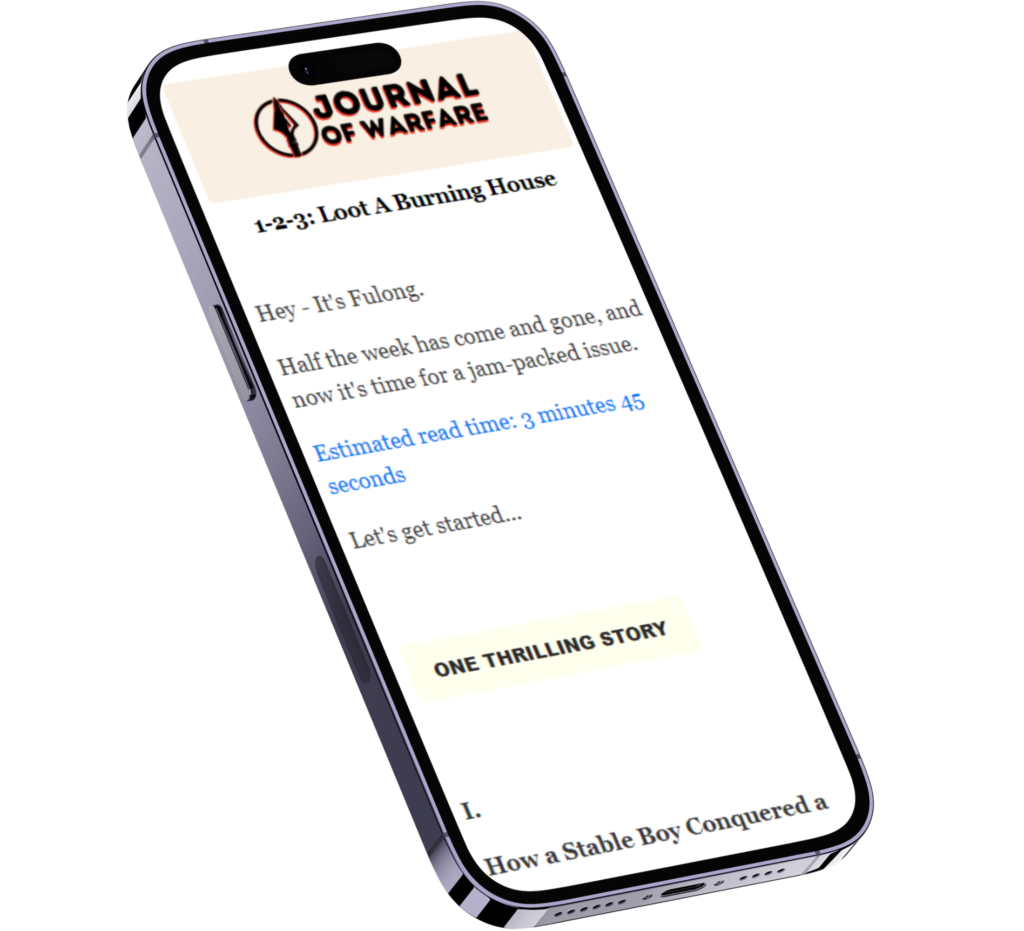Hey – It’s Fulong.
Half the week has come and gone, and now it’s time for a jam-packed issue.
Estimated read time: 2 minutes 50 seconds
Let’s get started…
One Thrilling Story
I.
How Lincoln Turned The Tide Of The Civil War
By early 1864, the American Civil War had settled into a stalemate. This was particularly frustrating for U.S. President Abraham Lincoln who was facing an election later that year.
If this sad state of affairs continued, not only would he likely lose the election, but the situation would play right into the hands of the Confederates (they hoped to draw out the war long enough to force his government to the negotiating table).
Gravely worried, Lincoln decided to name Ulysses S. Grant as the overall commander of the Union forces – here was a man who would go on the offensive.
One of Grant’s first moves was to name his chief lieutenant, General William Tecumseh Sherman, as commander of the Unionist forces in Georgia.
His main job in Georgia was to capture the key industrial city of Atlanta, yet, he soon realized that to get to Atlanta, he would first have to take the Confederate stronghold of Dalton which blocked his path.
The commander at Dalton, General John Johnston, was a master of defensive warfare. With mountains to his rear and a solid position to his front, all Johnston had to do was stay put. After all, for Sherman, a frontal assault would be suicidal and a siege would simply take too long.
So, Sherman decided to employ trickery. If he could not seize Dalton directly, he would take hold of Johnston’s mind instead. In May that year, Sherman sent three-fourths of his army to a frontal assault, then sneaked the rest around the mountains to Resaca town 15 miles south.
In doing so he blocked Johnston’s only path of retreat and cut his supply lines. Spooked and now surrounded, Johnston gave up his position at Dalton.
He would not, however, play into Sherman’s hands; he simply retreated into another defensive position. This became a dance of sorts – Johnston would invite Sherman to attack frontally, and Sherman would out-maneuver him and force him to give up his position. This happened again and again… all the way to Atlanta.
By now disgusted with his refusal to fight, Confederate President Jefferson Davis replaced Johnson with General John Hood. Hood was more aggressive, Sherman knew, and even reckless sometimes.
Sherman had no time to lay siege on Atlanta – Lincoln needed a quick victory. So, using Hood’s aggression against him, Sherman sent small detachments to threaten Atlanta’s defenses.
Seeing this, Hood was baited into leaving his stronghold to attack these seemingly weak contingents, but once he was out, he found himself rushing into an ambush. This happened repeatedly, and with each defeat, Hood’s army became smaller while morale amongst his men plunged lower.
With Hood’s army now weary and tired, Sherman played another trick. He abandoned his supply lines and marched his army southeast, past Atlanta. To Hood, this could only mean Sherman had given up on Atlanta, and soon wild celebrations broke out in the city.
But the Sherman had cunningly timed this march to coincide with the harvest season, which meant his men could live off the land without their supply lines. Well-fed and Hood unsuspecting, he cut the final railway line still open to Atlanta and wheeled back to attack the unguarded city.
Sherman forced Hood into abandoning Atlanta and thus secured the great victory that would ensure Lincoln’s re-election.
Two Warfare Tips
I.
Dance The Enemy To Your Tune
The temptation for the Unionist forces was to fight on the enemy’s terms, and hurl division after division against their positions, at a tremendous loss of life and with little chance of advancing.
This was in the interests of the South – the longer this stalemate continued, Lincoln would be thrown out of office, and the war would end through negotiation.
Knowing this, Sherman turned the tables and forced the enemy to dance to his tune.
He moved fast here and slow there; he injected novelty and mobility into his tactics to unbalance the rigid minds of his opponents.
II.
Attack Their Minds
Employing psychological warfare, Sherman frightened the timid Johnson into abandoning his stronghold and goaded the rash Hood into senseless attacks.
In both instances, he played upon their psychology to force the issue. By putting his enemy into what he called the ‘horns of a dilemma’, where both moving and staying put were equally dangerous, he took control of the situation without having to waste men in battle.
Three Favourite Quotes
I.
Sun Tzu on knowing the enemy:
“If you know the enemy and know yourself, you need not fear the result of a hundred battles.”
II.
Frederick the Great on keeping the enemy occupied:
“In order to have rest oneself, it is necessary to keep the enemy occupied. This throws them back on the defensive, and once they are placed that way they cannot rise up again during the entire campaign.”
III.
Miyamoto Musashi on controlling the dynamic:
“In battles based on martial strategy, it is taboo to let your opponent take the initiative, thus putting yourself on the defensive. You must try at all costs to lead your opponent by taking complete control of him.”
See you sooner or later — Fulong


